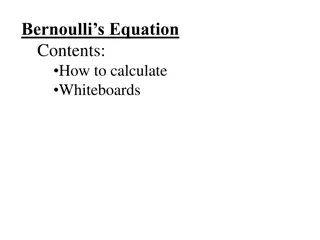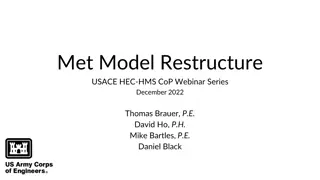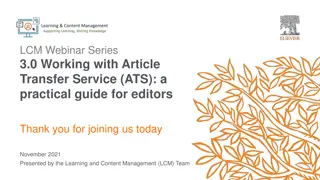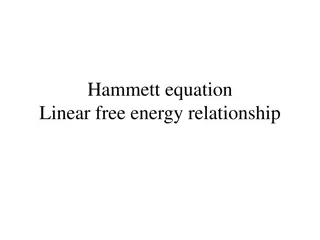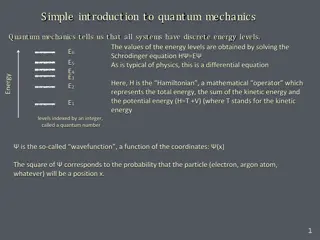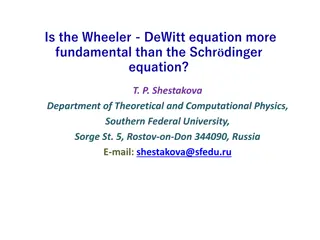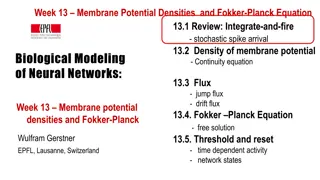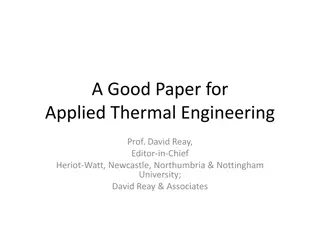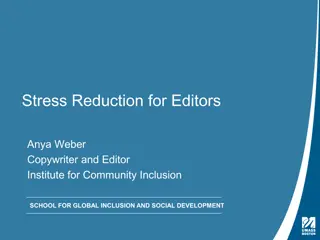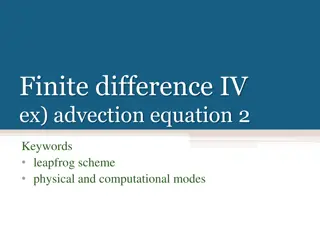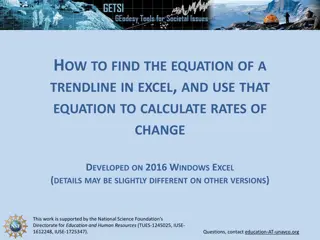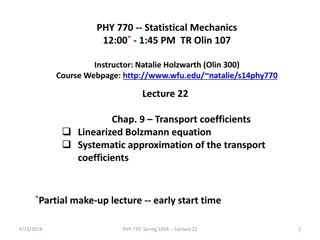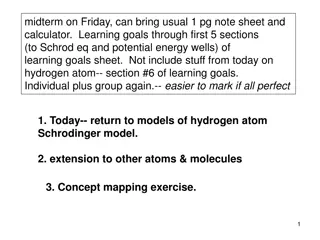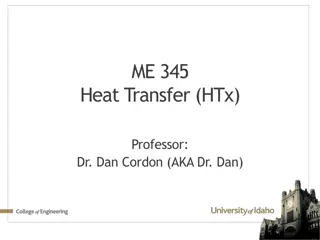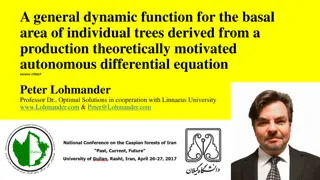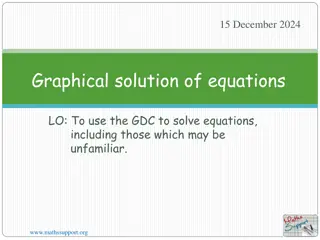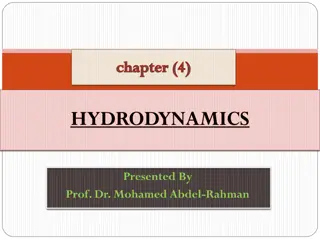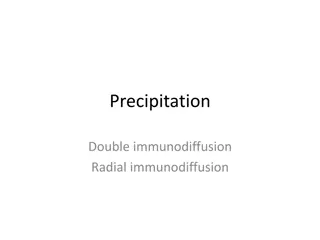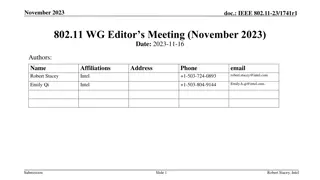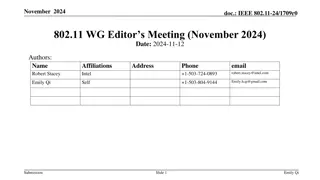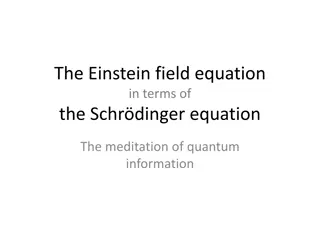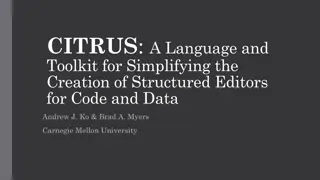Bernoulli's Equation in Fluid Mechanics
Bernoulli's equation, a fundamental principle in fluid dynamics, relates pressure, kinetic energy, and potential energy of a fluid flowing in a pipe. Through examples and explanations, explore how this equation can be used to calculate velocity, pressure differences, and forces in various scenarios
1 views • 12 slides
Restructuring of USACE HEC-HMS Meteorologic Model
Significant modifications have been made to the HEC-HMS meteorologic model to enhance modeling tasks' ease and intuitiveness. The Met Model Restructure updates in versions 4.9 to 4.11 streamline meteorologic processes, introduce new features like automatic linkages and zonal editors for snowmelt, an
0 views • 19 slides
Practical Guide for Editors: Working with Article Transfer Service (ATS)
A comprehensive webinar series exploring the intricacies of Article Transfer Service (ATS) within Elsevier, highlighting its importance, benefits, workflows, and connections in Editorial Manager. Editors learn how ATS streamlines manuscript transfers between journals, benefiting both authors and edi
0 views • 14 slides
The Hammett Equation in Chemical Reactions
The Hammett equation explores how substituents influence the dissociation of benzoic acid, affecting its acidity. By quantifying this influence through a linear free energy relationship, the equation helps predict the impact of substituents on different processes. Through parameter definitions and m
1 views • 9 slides
Introduction to Dynamic Structural Equation Modeling for Intensive Longitudinal Data
Dynamic Structural Equation Modeling (DSEM) is a powerful analytical tool used to analyze intensive longitudinal data, combining multilevel modeling, time series modeling, structural equation modeling, and time-varying effects modeling. By modeling correlations and changes over time at both individu
3 views • 22 slides
Comprehensive Overview of Freezing Time Methods in Dairy Engineering
Neumann, Tao, and Non-Dimensional methods are key approaches for determining freezing times in unsteady state heat transfer processes in dairy engineering. The Neumann Problem, Tao Solutions, and Cleland and Earle Non-Dimensional Equation offer distinct equations and models to calculate freezing tim
1 views • 8 slides
A Comprehensive Guide to MathML and LaTeX Workflow 2017
Delve into the intricacies of MathML and LaTeX workflow in 2017 with insights on equation editors, commonly used equations, comparison between Wiris and MathType, LaTeX usage in STEM research, and more. Uncover tips, workarounds, and new developments in MathJax setup since 2016, along with the impor
0 views • 40 slides
Introduction to Quantum Mechanics: Energy Levels and Schrödinger Equation
Quantum mechanics reveals that all systems possess discrete energy levels, determined by solving the Schrödinger equation where the Hamiltonian operator represents total energy. In a particle-in-a-box scenario, potential energy is infinite outside the box. The Schrödinger equation simplifies to a
1 views • 12 slides
Fundamental Comparison: Wheeler-DeWitt vs. Schrödinger Equation
The debate on whether the Wheeler-DeWitt equation is more fundamental than the Schrödinger equation in quantum gravity remains inconclusive. While the Wheeler-DeWitt equation presents an elegant formulation, the Schrödinger equation is essential in specific cases. The issue of time and coordinate
0 views • 6 slides
Membrane Potential Densities and the Fokker-Planck Equation in Neural Networks
Delve into the concepts of membrane potential densities and the Fokker-Planck Equation in neural networks, covering topics such as integrate-and-fire with stochastic spike arrival, continuity equation for membrane potential density, jump and drift flux, and the intriguing Fokker-Planck Equation.
0 views • 29 slides
Insights into the Editorial Process of Applied Thermal Engineering Journal
Applied Thermal Engineering journal, under the leadership of Editor-in-Chief Prof. David Reay, has a rich history dating back to 1981. The journal's evolution, from its origins as Heat Recovery Systems to its current name and scope, reflects its commitment to advancing thermal engineering knowledge.
0 views • 29 slides
Unleashing the Power of Web Components for Editors
Explore the world of web components and how they can enable editors to create reusable, customizable content easily. Learn about custom elements, Shadow DOM, and lifecycle functions that enhance the capabilities of web development without relying on frameworks.
0 views • 15 slides
Effective Stress Reduction Strategies for Editors
Discover practical tips and techniques for reducing stress in your editing work. From mindfulness practices to the benefits of meditation, this insightful content offers valuable insights to help editors stay calm and focused amidst demanding work environments. Embrace these stress-relief methods to
0 views • 39 slides
Leapfrog Scheme for Advection Equation
The provided images illustrate the Leapfrog scheme applied to an advection equation, focusing on the center method in time and space. The stability of the method is analyzed with assumptions regarding the behavior of the solution. Through the exploration of Courant numbers and CFL conditions, the st
0 views • 25 slides
Excel Tutorial: Finding Trendline Equation and Calculating Rates of Change
Learn how to find the equation of a trendline in Excel and use it to calculate rates of change. This step-by-step guide includes importing data, adding a trendline, displaying the equation, and interpreting it for analysis. Make the most of Excel's features for data analysis.
1 views • 11 slides
Linearized Boltzmann Equation in Statistical Mechanics
This lecture delves into the linearized Boltzmann equation and its applications in studying transport coefficients. The content covers the systematic approximation of transport coefficients, impact parameters of collisions, and the detailed solution for a dilute gas system. It explores the notation
0 views • 25 slides
Quantum Chemistry Learning Goals and Concepts
This content covers the learning goals and concepts of quantum chemistry leading up to the Schrodinger equation and potential energy wells, excluding the material on the hydrogen atom introduced later. It explores models of the atom, including observations of atomic spectra, the Bohr model, de Brogl
0 views • 22 slides
Unlocking Writing Techniques: Tips for Crafting Persuasive Letters to Newspaper Editors
Explore valuable writing techniques to enhance letters addressed to newspaper editors. Learn how to structure ideas effectively, utilize impactful punctuation, develop persuasive arguments, and engage readers with compelling language. Enhance your writing skills to make a powerful impact.
0 views • 12 slides
Analytical Solutions for 2D Heat Equation with Separation of Variables
Consider the steady-state 2D heat equation with constant thermal conductivity. Analyze analytical solutions using separation of variables method for a square plate with defined boundary conditions. Learn how to express the general form of solutions and apply them to the heat equation in Cartesian ge
0 views • 15 slides
Developing Anti-Bias Training Framework for Editors
Explore the framework for developing anti-bias training tailored for journal and book editors. Learn key steps such as problem description, intention setting, engaging allies, content commissioning process, reflection questions, and identifying who is involved. Dive into pre-work reflection exercise
0 views • 9 slides
Dynamic Function for Basal Area of Trees Derived from Differential Equation
Mathematical methods presented by Braun and Simmons are used to derive a dynamic function for the basal area of individual trees from a production-theoretically motivated autonomous differential equation. The differential equation and general dynamic function are described, highlighting the relation
0 views • 45 slides
Role of Editors in Media in South East Europe: Research Findings
Research funded by the European Union examines the role of editors in the media in six South East European countries. The study evaluates factors influencing editors' work, including regulation, education, hiring procedures, and economic/political situations. Findings reveal challenges in legislatio
0 views • 9 slides
Analysis and Comparison of Wave Equation Prediction for Propagating Waves
Initial analysis and comparison of the wave equation and asymptotic prediction of a receiver experiment at depth for one-way propagating waves. The study examines the amplitude and information derived from a wave equation migration algorithm and its asymptotic form. The focus is on the prediction of
0 views • 23 slides
Insights into Editors' Objectives and Challenges in Academic Publishing
Understanding the objectives of editors in academic publishing is crucial for researchers. Their goals include attracting more readers, increasing citations, maintaining high quality, managing limited resources, and protecting referees. The toughest challenges involve convincing editors and referees
0 views • 9 slides
Comprehensive Guide to Ontology Editors and IDEs for Ontologies
Explore a wide range of Ontology Editors and Integrated Development Environments (IDEs) for managing ontologies efficiently. From simple text editors to advanced IDEs like Protégé and Web Protege, learn about various tools and syntax options available. Dive into Ontology Editors like Protégé 4.3
0 views • 16 slides
Graphical Solution of Equations Using GDC - Step-by-Step Guide
Learn how to solve equations graphically using a Graphic Display Calculator (GDC) with step-by-step instructions. Turn on the GDC, input the equation on Y1 and Y2, draw the graphs, and find the intersection point to determine the x-value. An example equation, 2x + 8 = x + 1, is solved using this met
0 views • 20 slides
IEEE 802.11-24 Editors Meeting Agenda and Report
This document captures the discussions, updates, and planned actions from the March 2024 IEEE 802.11 Editors Meeting. Topics covered include draft alignments, upcoming publications, editor contacts, MDR/MEC ANA spaces, and amendment ordering data. The report also outlines the status of ongoing tasks
0 views • 17 slides
Hydrodynamics: Bernoulli's Equation and Fluid Flow Analysis
Understanding Bernoulli's equation in hydrodynamics is key to analyzing fluid flow dynamics. As a fluid moves through varying pipe conditions, pressure, speed, and elevation interact to maintain a constant total energy. This principle, expressed in Bernoulli's equation, showcases the relationship be
0 views • 16 slides
Balancing Chemical Equations: Aluminum and Oxygen Reaction
In this interactive drill, you will practice balancing the chemical equation for the reaction between aluminum and oxygen to form aluminum oxide. Follow the step-by-step process provided for each part of the equation to ensure accuracy. Start with the word equation and progress to the balanced chemi
0 views • 22 slides
IEEE 802.11 September 2024 Editors Meeting Report
This document captures the proceedings of the IEEE 802.11 Editors Meeting held in September 2024, including roll call, status reports, amendment alignments, draft development snapshots, and plans for finalizing review processes. It also highlights volunteer editor contacts, meeting roundtable status
0 views • 15 slides
Nurturing Investigative Journalism: Editor-Journalist Collaboration
Explore the crucial role of editors in nurturing investigative journalists through guidance, mentorship, support, and ensuring safety. Learn how editors assist in fact-checking, mental health support, and upholding integrity in journalism. Uncover key areas of collaboration for producing impactful i
0 views • 4 slides
Omega 1320 Programming Guide: Create, Edit, and Save Programs Easily
Learn how to create and edit programs on Omega 1320 using popular editors like Vim, Nano, Emacs, and Pico. Follow the step-by-step instructions to write your code, switch between editors, and save your work efficiently. Discover tips for navigating different modes, exiting editors, and seeking help
0 views • 10 slides
IEEE 802.11-25/0097r1 January 2025 Editors Meeting Report
Dive into the detailed agenda and discussions from the IEEE 802.11 Editors Meeting held in January 2025. Follow the progress, amendments, and future plans for publications within the IEEE 802.11 working group. Stay informed about the status report, volunteer editor contacts, and upcoming deadlines f
1 views • 16 slides
IEEE 802.11-23/1741r1 November 2023 Editors Meeting Highlights
Dive into the key discussions and updates from the IEEE 802.11-23/1741r1 Editors Meeting held in November 2023. Explore agenda points, volunteer editor contacts, status reports, and more regarding TGbe, TGbf, TGbh, TGbi, TGbk, and REVme activities within the IEEE 802.11 Working Group.
0 views • 19 slides
Ontology Editors, IDEs, and Syntax: Tools for Effective Ontology Development
Explore ontology editors, Integrated Development Environments (IDEs), and syntax options for efficient ontology creation, such as Protege, Web Protege, Manchester OWL Syntax, and data values and datatypes. Learn about popular tools, features, and best practices for managing ontologies effectively.
0 views • 16 slides
IEEE 802.11-24/1709r0 Editors Meeting November 2024
Explore the agenda, minutes, and developments discussed at the IEEE 802.11 Editors Meeting in November 2024. Learn about the amendments, editorial style guide updates, and volunteer editor contacts. Stay informed about the progress and upcoming initiatives in the field of IEEE 802.11 standards.
1 views • 16 slides
Einstein Field Equation and Schrödinger Equation Relationship
Explore the connection between the Einstein field equation and the Schrödinger equation through the lens of quantum information and qubits. This concept delves into the deformation of spaces and the transition from future to past in a quantum framework.
0 views • 51 slides
Introduction to HTML Basics and Structure
Discover the fundamental concepts of HTML, including markup tags, web browsers, HTML documents, URLs, and XHTML. Learn about creating and editing HTML pages using text editors and web page editors. Gain insights into the importance of Uniform Resource Locators (URLs) in web addressing. Dive into the
0 views • 48 slides
Simplifying Structured Editors for Code and Data with Citrus Language and Toolkit
Explore Citrus, a language and toolkit designed to simplify the creation of structured editors for code and data. Learn about its features, specifications, user interface toolkit, and examples like a to-do list. Discover how Citrus revolutionizes interactive tools for reshaping and utilizing structu
0 views • 7 slides
Guidelines for Ethical Conduct in Journal Editing
Explore the comprehensive Code of Conduct for Journal Editors, which outlines the responsibilities editors must uphold, including ensuring the quality of published material, disclosing funding sources, and making decisions based on paper relevance and validity.
0 views • 20 slides
